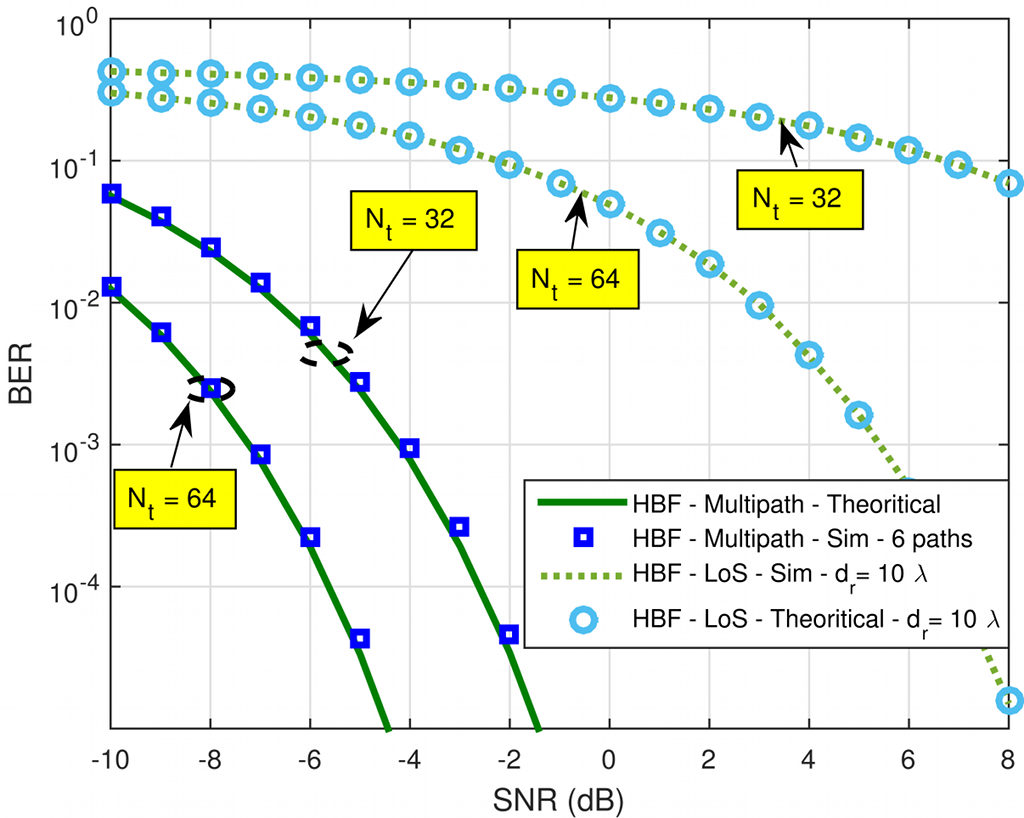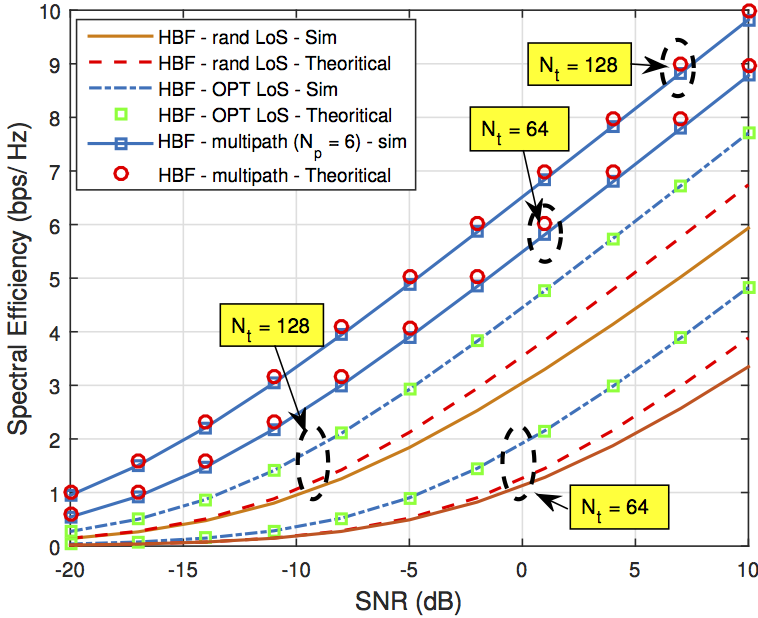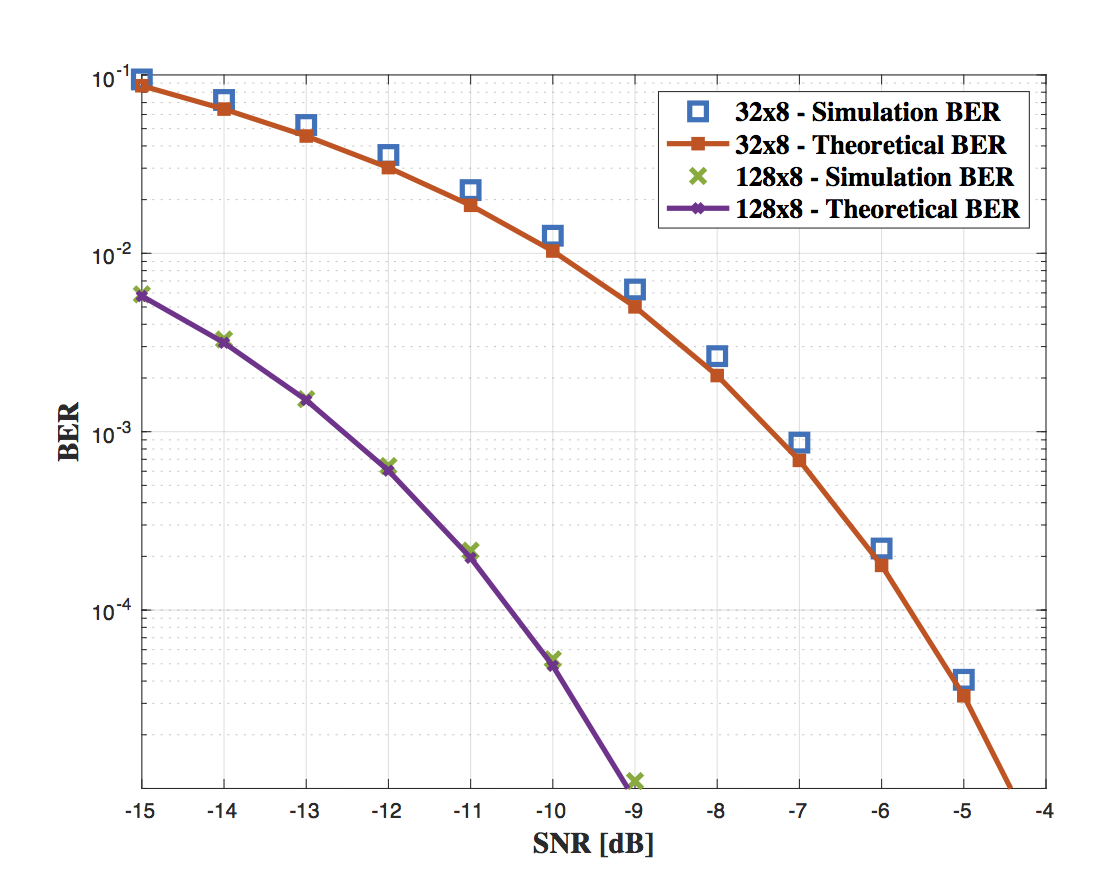In this part of the work, we have proposed to exploit the previously studied characteristics of mmWave systems and channels to design new robust and spectral efficient communication mechanisms based on spatial modulation concepts. More precisely, we have investigated in which extent spatial modulation could be carried out for the downlink of a cellular system in millimeter bands. The idea is to exploit the low complexity-energy efficient paradigm offered by spatial modulation schemes, with a possible application to the IoT (Internet of Things) context. To that aim, two study cases have been selected, with in each case the theoretical analysis of performance :
- Hybrid Beamforming combined with Receive Spatial Modulation (HBF-RSM)
- Hydrid Beamforming combined with Beam Index Modulation (HBF-BIM)
Theoretical performance of HBF-RSM
Receive Spatial Modulation is expected to be a low complex solution for the future Internet of Things receivers, while achieving reduced Bit Error Rate (BER). RSM basically consists in focusing propagated waves to some of the antennas of a receive array through beamforming strategies. Yet, as mmWave channels are characterized by being Line of Sight (LoS) dominated (see WP3 studies), it is interesting to study whether focusing capabilities in such propagation environment are efficient or even at least compatible with RSM principles. Moreover, such question becomes even more an issue considering antenna arrays deployed at the transmitter or the receiver with much less Radio Frequency (RF) chains through hybrid beamforming.
Hence, we have considered a system model combining hybrid beamforming and receive spatial modulation (HBF-RSM) as presented Fig 1. We have analytically studied the optimal achieved Spectral Efficiency (SE) and BER. We have focused on a practical deployment case in which the receiver is employed with two receive antennas. We have derived the achieved BER in a pure LoS environment as well as in a general multi-path channel environment (see Fig. 2a). Theoretical spectral efficiencies have also been obtained (see Fig. 2b). The analysis has been led for hybrid beamforming at the transmitter utilizing massive Multiple Input Multiple Output (MIMO) array with only two RF chains, thus unleashing the gains that can be achieved by RSM in realistic mmWave system with minimal hardware complexity.
Theoretical performance of HBF-BIM
In this last contribution, a novel Beam Index Modulation (BIM) architecture with hybrid beamforming is introduced for millimeter-wave (mmWave) communications (see Fig.3). Spatial Scattering Modulation (SSM) and BIM have recently been proposed as a potential extension of Spatial Modulation (SM) to deal with sparse non Line of Sight (nLoS) channel environments. However, these approaches only consider single stream scenario, thus limiting the achievable multiplexing gains. More recently Generalized Beamspace Modulation (GBM) was introduced to add such multiplexing gain to the spatial information conveyed by the beams. However, GBM only considers analog beamforming and combining and does not leverage the digital processing gains. Therefore, we have proposed a new Generalized BIM architecture relying on hybrid beamforming at the transmitter side and analog combining at the receiver side. Through such approach, it is possible to achieve higher Spectral Efficiency (SE) and lower Bit Error Rate (BER) compared to the previously proposed BIM, SSM and GBM. We have analyzed the performance of our proposal by deriving the analytic closed form expressions of the achievable SE and bit error probability (see Fig 4a and 4b). Simulation results show the validity of our theoretical results and highlight the performance gain brought by the hybrid beamforming strategy applied to generalized BIM mmWave communications.







